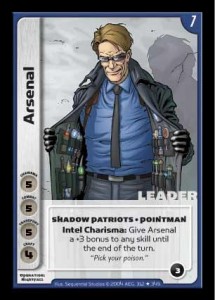When Kevin first got interested in game design in the late ’90s and early ’00s, he was obsessed with CCGs. His favorite company was AEG, which always seemed to hit it out of the park with flavorful, innovative games like Legend of the Five Rings, 7th Sea, Doomtown, and Warlord. So when he heard they were working on a spy game, he was naturally psyched. The coolest part: You could play cards face down! How cool and flavorful was that?
When Spycraft hit, he rushed out to buy some starters and enlisted Sam to try it out. The game was fine, but somewhat disappointing. And naturally, the most disappointing thing was the thing we were most excited about: the face-down mechanic. It seemed pretty tacked on. For a card to actually do anything, it usually had to be turned face up first, making the whole affair seem much less shadowy.
So when we were coming up with every which thing you could do with a playing card, we hit on the idea of making our own spy game with face-down cards, one that did everything we’d wanted Spycraft to do. It would be all about the face-down cards.
Fool Me Once…
This is trickier than it sounds. Face-down cards convey no information. In a card game, it should matter what your cards are, and it’s hard to pull that off when they could be anything. We also wanted cards to be more powerful face down than face up, so players would want to keep their cards that way, but what mighty power do you bestow on any generic unknown card?
The obvious answer was to make the lack of information conveyed a feature instead of a bug, to make the game about sneakiness and subterfuge. Face down cards, we decided, gained power precisely because your opponent didn’t know what they were. Face down cards could do anything, provided you were sneaky enough. Suit Abilities seemed like a good way to accomplish this. There would be four distinct powers to remember, and they would form the basic actions of the game. A face-down agent could pretend to have any ability.
There are a handful of reliable tricks in the game designer’s arsenal that pretty much always work, and one of them is to introduce bluffing into the game. It’s a fairly simple formula: Introduce hidden information. Give one player the ability to lie, and an incentive for doing so, but also a risk for being caught. Give his opponents a reward for catching him, but a downside risk if they’re wrong. Ideally, there should be clues a savvy opponent can pick up on to help him decide if you’re full of shit. It’s a familiar dynamic, but it’s constantly tense.
Fool Me Twice…
That seemed like just the kind of thing you want for a game about spies and subterfuge, and we needed a way to make sure the front of the cards mattered, so it seemed obvious that opponents would have to be able to call you on it when you pretended to have an ability. This posed a bit of a conundrum, because then you’d have to reveal the character even if you were telling the truth, so we had to give you some compensation. Using the ability twice felt powerful and fun for the player doing it, and good enough to give you pause instead of calling out every ability.
As an extra measure to make face-down cards stronger, we made face-up cards easier to get rid of. We created the Spade ability, which can kill any face-up card in the field. This gave you another reason to keep your agents on the down-low, and it made flavor-sense–of course exposed agents are more vulnerable to attacks!
Your Mission, If You Choose To Accept It
Our game system was starting to come together, but we still didn’t actually have any idea how you won the game. Since the game was all about subterfuge, it seemed like it might be fun if your objective itself was a secret.
We should pause for a public service announcement for designers out there: Giving each player a different, random victory condition is perilous territory. We’ve had it backfire in more than one design. When all your game elements aren’t focused on a constant victory condition or set of victory conditions, they tend to lose focus. It becomes hard to tell what’s “good,” and hence hard to cost and balance things. And it’s really hard to balance the dang victory conditions themselves.
But for Spycard, it worked. Indeed, it became the secret sauce that made the game fun. Giving players the ability to expose each other to knock them out of the game gave the proceedings an awesome level of tension. It wasn’t enough to move towards your goal, you had to do it sneakily, and that made you feel like a spy. Quirks of the game suddenly became features. Yes, sometimes calling out someone as a liar and being wrong was advantageous, but we had no problem with that if you were intentionally doing it to reach your goal. The actions don’t seem focused, but that’s fine; it’s not like you’re stuck with the ones you draw. You can have whichever action you need if you’re willing to lie. Finally, all players still have a common victory condition: Expose everybody else. We’ll be honest, we’re still not entirely sure all the missions are balanced, but in our tests they seem reasonably close. The game is also pretty fast, which makes players more forgiving of slight imbalances. In long games, if you have a very difficult objective, you might feel a sense of hopelessness creeping in. In Spycard, you’ll probably have a bullet in your brain long before that, and you can always switch to detective mode and just try to expose others, or get them to guess wrong when trying to expose you.
This Message (And You) Will Self-Destruct
The exposure rule is dramatic and appealingly simple: If you guess right, they’re out, if you guess wrong, you’re out. But you might notice that it’s also kind of harsh. The upside is eliminating one of your opponents, of whom you have more than one, increasing your odds of victory, but the downside is losing the game entirely. This is intentional. Getting kicked out of a game isn’t a feel-good moment for most people, so we don’t want it happening all the time. Making the downside worse than the upside ensured you’d only do it if you were really sure–it’s almost never the mathematically correct play if you assumed you had no knowledge.
From its first playtest on, Spycard was a blast. We were a bit surprised by how fast the game was, but it wound up working in the game’s favor. Getting eliminated when an opponent guessed your identity would probably have felt bad in a 45-minute game, but not in a 15-minute game. What’s odd about Spycard is that usually games with its play time are very simple, whereas Spycard is very complex. We were initially worried that players wouldn’t want to learn so much for a game so short, but in our tests people were usually perfectly willing to shuffle them up and play again… and again… and again.
Try it for yourself – you’ll be glad you did, or your money back, no questions asked.


